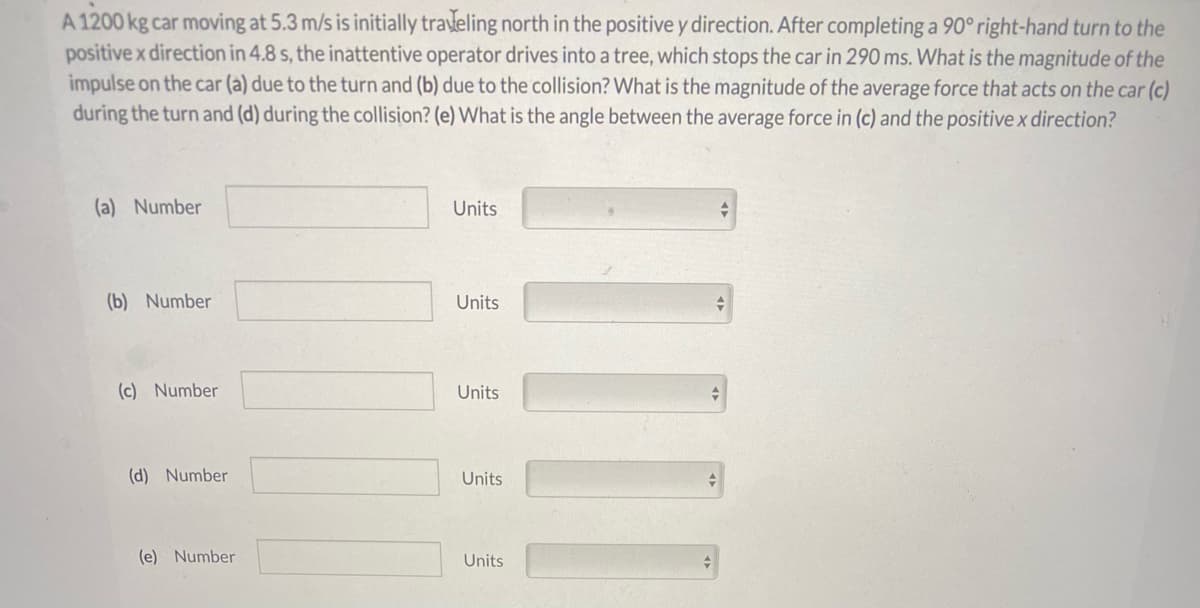A 1200 kg car moving at 5.3 m/s is initially traveling north in the positive y direction. After completing a 90° right-hand turn to the positive x direction in 4.8 s, the inattentive operator drives into a tree, which stops the car in 290 ms. What is the magnitude of the impulse on the car (a) due to the turn and (b) due to the collision? What is the magnitude of the average force that acts on the car (c) during the turn and (d) during the collision? (e) What is the angle between the average force in (c) and the positive x direction?
A 1200 kg car moving at 5.3 m/s is initially traveling north in the positive y direction. After completing a 90° right-hand turn to the positive x direction in 4.8 s, the inattentive operator drives into a tree, which stops the car in 290 ms. What is the magnitude of the impulse on the car (a) due to the turn and (b) due to the collision? What is the magnitude of the average force that acts on the car (c) during the turn and (d) during the collision? (e) What is the angle between the average force in (c) and the positive x direction?
Principles of Physics: A Calculus-Based Text
5th Edition
ISBN:9781133104261
Author:Raymond A. Serway, John W. Jewett
Publisher:Raymond A. Serway, John W. Jewett
Chapter8: Momentum And Collisions
Section: Chapter Questions
Problem 46P: A rocket has total mass Mi = 360 kg, including Mfuel = 330 kg of fuel and oxidizer. In interstellar...
Related questions
Topic Video
Question

Transcribed Image Text:A 1200 kg car moving at 5.3 m/s is initially traveling north in the positive y direction. After completing a 90° right-hand turn to the
positive x direction in 4.8 s, the inattentive operator drives into a tree, which stops the car in 290 ms. What is the magnitude of the
impulse on the car (a) due to the turn and (b) due to the collision? What is the magnitude of the average force that acts on the car (c)
during the turn and (d) during the collision? (e) What is the angle between the average force in (c) and the positive x direction?
(a) Number
Units
(b) Number
Units
(c) Number
Units
(d) Number
Units
(e) Number
Units
Expert Solution
This question has been solved!
Explore an expertly crafted, step-by-step solution for a thorough understanding of key concepts.
Step by step
Solved in 3 steps with 3 images

Knowledge Booster
Learn more about
Need a deep-dive on the concept behind this application? Look no further. Learn more about this topic, physics and related others by exploring similar questions and additional content below.Recommended textbooks for you

Principles of Physics: A Calculus-Based Text
Physics
ISBN:
9781133104261
Author:
Raymond A. Serway, John W. Jewett
Publisher:
Cengage Learning

Physics for Scientists and Engineers
Physics
ISBN:
9781337553278
Author:
Raymond A. Serway, John W. Jewett
Publisher:
Cengage Learning

Physics for Scientists and Engineers with Modern …
Physics
ISBN:
9781337553292
Author:
Raymond A. Serway, John W. Jewett
Publisher:
Cengage Learning

Principles of Physics: A Calculus-Based Text
Physics
ISBN:
9781133104261
Author:
Raymond A. Serway, John W. Jewett
Publisher:
Cengage Learning

Physics for Scientists and Engineers
Physics
ISBN:
9781337553278
Author:
Raymond A. Serway, John W. Jewett
Publisher:
Cengage Learning

Physics for Scientists and Engineers with Modern …
Physics
ISBN:
9781337553292
Author:
Raymond A. Serway, John W. Jewett
Publisher:
Cengage Learning

Classical Dynamics of Particles and Systems
Physics
ISBN:
9780534408961
Author:
Stephen T. Thornton, Jerry B. Marion
Publisher:
Cengage Learning

Physics for Scientists and Engineers: Foundations…
Physics
ISBN:
9781133939146
Author:
Katz, Debora M.
Publisher:
Cengage Learning